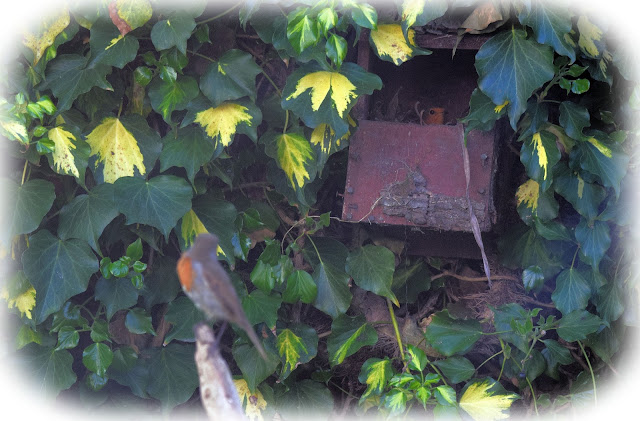Like many people before me I suspect, that the effort of placing a bird nesting box in the garden should be rewarded almost immediately by a grateful bird who has been waiting for just such a nesting opportunity to arise. this is often not the case and appears very hit and miss, and in my case very much a miss. But things were about to change as you will see.
So an olde bird box found at the back of the greenhouse, complete with cobwebs was spruced up and pushed into the ivy at the back of the pond, strategically placed near our new conservatory window, more as a garden ornament than a potential home and forgotten.
A miracle has occurred, as my wife and I sat in our conservatory with tea and toast, our garden Robin caught our eye, it was hovering around the ivy, I thought it was looking for a meal, with complete disbelief it flew into the nesting box. I was stunned, I looked at my wife and we both said at the same time "did that really happen"
Still thinking that the Robin had spotted a tasty morsel within the bird box and certainly not considering moving in. we thought no more of it.
Then the impossible began to happen before our very eyes, the Robin and I believe the female, began to appear on my old timber perches around the pond with nesting material, mainly dead leaves of all shapes and sizes flying in and out of the half fronted nesting box, occupation was truly under way, and continued for most of the day.
 |
| Female Robin collecting nesting material |
 |
| Male Watching over nest building procedures |
The male Robin appeared to take no part in the nest building which was all carried out by the female on day one.
 |
| Female Robin leaving nesting box. |
Day two and the nesting material being brought to the nest box had changed, now mainly moss and this activity appeared to cease about midday when I believe the nest was completed.
The next two days it appeared that all activity had ended, in fact there was no sign of the female and the bird box looked abandoned, the male occasionally turned up and sat on top of the feeder, calling occasionally
My curiosity got the better of me, I decided to take a quick peep at the nest box to see if it had been abandoned. Big mistake, as I peered into the box the Robin flew out brushing against my face, causing me to teeter backwards , arms a flailing I just managed to regain my balance preventing an early plunge into the fish pond. what an idiot.
Fortunately the Robin returned, my research had said that they are very susceptible to disturbance, but this pair seem accustomed to human activities close by.
What I did not realise was that the female had already begun her egg laying activity, usally one egg a day, this starts as soon as the nest is ready, the usual clutch being four eggs.
The incubation period is another fourteen days so an expectant date is imminent now.
Although the male was not involved in the nest building activities, he has been very diligent in his courtship behavior, visiting the nest box with tasty morsels for the female.
The female rarely ventures from the nest box, just early morning and late afternoon for a few minutes at a time before she returns. The male provides her with food, she takes a drink, a quick preen and she makes her way back.
 |
| Courtship feeding by male |
 |
| female returning to nest box |
My wife decided to supplement their feeding and during a trip to the local aquatic center, surrounded by reptiles of all shapes and sizes, my wife inquired of a young sales assistant , the availability of meal worms, what size would you require the sale assistant asked, and what type of reptile do you have. A surreal moment when my wife answered a Robin with a straight face,the sales assistant smiled kindly and pointed to a suitable box of meal worms.
But the Robin and the local Blackbirds who are also nesting close by, but out of sight, appear very grateful.
I have also noticed that my Moth trap has provided a meal or two for the male who was seen swooping down from the Pear tree in the hours of darkness, my moth trap acting as a 24/7 convenience store, probably the reason my moth catch has been poor.
 |
| Blackbird taking more than his share ! |
 |
| Male feeding female in Nest Box |
Having the Blackbirds nesting close by appears to be a smart move, like have a personal security and alarm service, any time an unwanted intruder ventures too close the male Blackbird goes into attack mode and sounds its distinctive alarm call..
 |
| Security and alarm service provided by Male Blackbird. |
 |
| The enemy. |
So far, so good, the nest box is still occupied, the incubation period should be coming to an end very soon, we are looking forward to the next stage of rearing the young.




























































